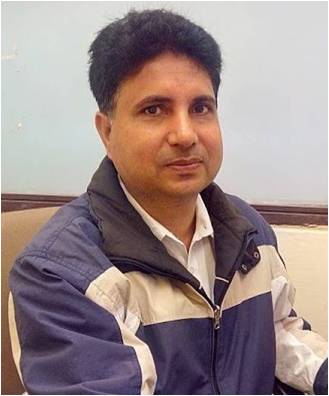
Prof. Dr. Rajiv Kumar Professor and Head (91)-01792-239261, +91-9816365801(M) rajiv.kumar@juit.ac.in, rajiv.kumar@juitsolan.in For More Information Click here
Rajiv Kumar received Bachelor of Technology from College of Technology, G.B. Pant University of Agriculture and Technology, Pant Nagar, India in 1994. He received M.Tech. from NIT Kurukshetra (formerly REC, Kurukshetra), India in 2001. He received his Ph.D. degree from NIT Kurukshetra in the year 2010. His areas of interest in research are networks and systems.
Research Interests:
Network Reliability, Resilience, Service Level Agreement (SLA), QoS Routing, Service Reliability, Cyber-Physical Systems, Networked Control Systems, Wireless Sensor Networks, Internet of Things (IoT).
Education:
M.Tech. and Ph.D. Thesis
PhD Supervisor:
(Sole Guidance)
1) Ashutosh Sharma(Enrollment No.166001), titled "Risk-Aware Communication Network Architecture And Planning" (Defended May, 2020)
(Joint Guidance)
1) Dinesh Sharma (Enrollment No. 176009), titled, “Proactive Connection Recovery Strategy for a Survivable Elastic Optical networks” (Defended April, 2021)
2) Ratish Kumar (Enrollment No. 186001), titled "Predictive Controller Based Delay Compensation Approaches in Networked Control System" (Defended April, 2022)
Current Doctoral Students:
1) MunishPatial (Enrollment No. 196004)
2) Vandana Devi (Enrollment No. 206001)
3) Aakanksha Sharma (Enrollment No. 206002)
4) Ravikant Sharma(Enrollment No. 206005)
5) Shalini Sharma (Enrollment No. 216005)
M.Tech. Supervisor:
(Sole Guidance)
1) Vinod Kumar (Enrollment No. 082003), titled "Modelling and Analysis of Networked Control Systems with Specific Issues of Network-Induced Delay" , 2012.
2) Ashutosh Sharma (Enrollment No.142006), titled “A Tuning based Multiconstrained Link weight Assignment for Optimized Data Transmission”, 2016.
3) Poonam Koundal (Enrollment No. 142011), titled “Analysis of round trip delay and path, and routing protocol in wireless sensor network” , 2016.
4) Ashit Chander (Enrollment No.152008), titled, “Adaptation to Non-Critical Failure and Performance Analysis of Optical WDM Networks” , 2017.
(Joint Guidance)
1) Swati Bhalaik (Enrollment No. 162006), titled, “Performance Analysis of Optical WDM Networks Using MATPLAN WDM”, 2018
2) Aman Sharma (Enrollment No. 16200), titled, “Some Performance Aspects of Wavelength Division Multiplexing”, 2018
3) Sanjay K. Singh (212055), titled, "Orion – Interactive optical Network", May 2023.
Undergraduate Project Work Supervising, 2021-2022:
IoT Based BOT for Military Applications: It is a B.Tech. 4th year students (Aditya, Avinash) project that is now in initial phase of conceptualization. The incorporation of various technologies in this project under one roof has given the path to achieve goals which have never been realized in such an efficient manner in the past. These technologies bring about a self relying and able machine to tackle situations on its own and ease a human’s job in the present day scenarios.
Open Projects:
1. Title: Multi-utiliy ECE department app:
Brief Desription:
A multi-utiliy ECE department mobile app with the following features:
• Students can connect with each other and faculty members
• All the information of students is linked to their account
• All department related common announcements will be made on the app
• Every student’s webkiosk data is available on the app (registered courses, attendance for each course)
2. Title: Multi-Robot Coordination
Brief Desription:
Using Robot Operating System (ROS), create a simulation where a drone recognises particular objects from its bird’s eye view and sends the location of those objects to a mobile robot (UGV). The mobile robot should be able to reach that object’s location autonomously.
3. Title: detection for autonomous driving
Brief Desription:
Create a simulation of a non-holonomic (2 wheeled or 4 wheeled) robot that can detect lanes visually and plan its path accordingly